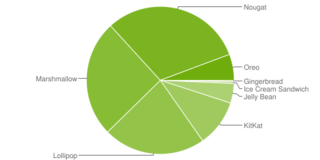source: http://en.wikipedia.org/wiki/Jelly_Bean_%28operating_system%29#Android_4.1.x_Jelly_Bean
Android 4.1 (Jelly Bean). Based on Linux kernel 3.1.10, Jelly Bean is an incremental update with the primary aim of improving the user interface, both in terms of functionality and performance. The performance improvement involves "Project Butter", which uses touch anticipation, triple buffering, extended vsync timing and a fixed frame rate of 60fps to create a fluid and "buttery"-smooth UI.[68] Android 4.1 Jelly Bean was released to AOSP on July 9, 2012,[69] and an OTA update for the Samsung Galaxy Nexus to Android 4.1.1 was released on July 11, 2012, making it the first device to run Jelly Bean.[70]
Version Release date Features 4.1.1 July 9, 2012
source: http://en.wikipedia.org/wiki/Android_(operating_system)
Android is an operating system for mobile devices such as smartphones and tablet computers.
Android 4.1 (Jelly Bean). Based on Linux kernel 3.1.10, Jelly Bean is an incremental update with the primary aim of improving the user interface, both in terms of functionality and performance. The performance improvement involves "Project Butter", which uses touch anticipation, triple buffering, extended vsync timing and a fixed frame rate of 60fps to create a fluid and "buttery"-smooth UI.[68] Android 4.1 Jelly Bean was released to AOSP on July 9, 2012,[69] and an OTA update for the Samsung Galaxy Nexus to Android 4.1.1 was released on July 11, 2012, making it the first device to run Jelly Bean.[70]
Version Release date Features 4.1.1 July 9, 2012
- Smoother user interface by:
- Vsync timing across all drawing and animation done by the Android framework, including application rendering, touch events, screen composition and display refresh
- Triple buffering in the graphics pipeline
- Enhanced accessibility
- Bi-directional text and other language support
- User-installable keyboard maps
- Expandable notifications
- Ability to turn off notifications on an app specific basis
- Shortcuts and widgets can automatically be re-arranged or re-sized to allow new items to fit on home screens
- Bluetooth data transfer for Android Beam
- Offline voice dictation
- New interface layout for tablets with smaller screens (closer resembling that of a phone)[71]
- Improved voice search
- Improved camera app
- Google Wallet (for the Nexus 7)
- High resolution Google+ contact photos[citation needed]
- Google Now
- Multichannel audio[72]
- USB audio (for external sound DACs)[72]
- Audio chaining (also known as gapless playback)[72][73][74]
source: http://en.wikipedia.org/wiki/Android_(operating_system)
Android is an operating system for mobile devices such as smartphones and tablet computers.
Android has seen a number of updates since its original release, each fixing bugs and adding new features. Each version is named, in alphabetical order, after a dessert.[42]
- Recent releases
- 2.3 Gingerbread refined the user interface, improved the soft keyboard and copy/paste features, improved gaming performance, added SIP support (VoIPcalls), and added support for Near Field Communication.[43]
- 3.0 Honeycomb was a tablet-oriented[44][45][46] release which supports larger screen devices and introduces many new user interface features, support for multi-core processors, hardware acceleration for graphics[47] and full system encryption.[48][49] The first device featuring this version, the Motorola Xoomtablet, went on sale in February 2011.[50][51]
- 3.1 Honeycomb, released in May 2011, added support for extra input devices, USB host mode for transferring information directly from cameras and other devices, and the Google Movies and Books apps.[52]
- 4.0 Ice Cream Sandwich, announced on October 19, 2011, brought Honeycomb features to smartphones and added new features including facial recognition unlock, network data usage monitoring and control, unified social networking contacts, photography enhancements, offline email searching, app folders, and information sharing using NFC. Android 4.0.3 Ice Cream Sandwich is the latest Android version that is available to phones. The source code of Android 4.0.1 was released on November 14, 2011.[55]
Android consists of a kernel based on the Linux kernel, with middleware, libraries and APIs written in C and application software running on an application framework which includes Java-compatible libraries based on Apache Harmony. Android uses the Dalvik virtual machine with just-in-time compilation to run Dalvik dex-code (Dalvik Executable), which is usually translated from Java bytecode.[56]
Usage share of the different versions, by December 1, 2011.[127]
- Version
| Distribution | API level | % |
|---|---|---|
| 4.0 Ice Cream Sandwich | 14-15 | 0% |
| 3.x.x Honeycomb | 11-13 | 2.4% |
| 2.3.x Gingerbread | 9-10 | 50.6% |
| 2.2 Froyo | 8 | 35.3% |
| 2.1 Eclair | 7 | 9.6% |
| 1.6 Donut | 4 | 1.3% |
| 1.5 Cupcake | 3 | 0.8% |
| Unix-like |
| |||||
|---|---|---|---|---|---|---|
| Other | ||||||
| Related platforms | ||||||

No comments:
Post a Comment